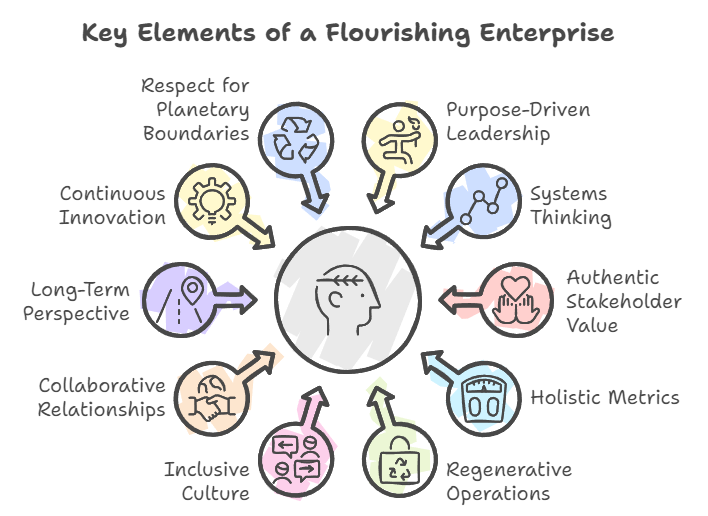Note: This post was developed in collaboration with the Flourishing Enterprise AI Advisor.In today’s increasingly interconnected world, sustainability is no longer sufficient. Enterprises must evolve from merely sustaining their operations to enabling flourishing—creating thriving environments for people, communities, and ecosystems. This transformation represents the reinvention of sustainability, where businesses don’t just aim to reduce harm but actively contribute to a world where everyone and everything can thrive. Welcome to the age of flourishing enterprises.
A flourishing enterprise doesn’t just meet sustainability targets; it strives to create authentic value for all stakeholders by aligning business success with the well-being of society and the planet. As businesses across industries begin adopting this model, they are proving that profitability and sustainability aren’t mutually exclusive—in fact, they are complementary.
Flourishing Enterprise: Sustainability Reinvented – A New Standard for Success
At the heart of a flourishing enterprise lies a purpose far greater than profit alone. These organizations embrace a vision that blends business success with positive environmental, social, and human impacts. Unlike traditional businesses, which often focus narrowly on shareholders, flourishing enterprises take a holistic, systems-based approach. This model integrates all types of capital—natural, social, human, and financial—to create long-lasting, regenerative value.
But how do organizations adopt the characteristics of flourishing? How do they apply a flourishing lens to achieve business success while contributing to a better world?
Applying a Flourishing Lens: The Path to Transformation

The transformation from traditional enterprise to flourishing enterprise requires a mindset shift. It begins by applying a flourishing lens to every facet of the organization, from strategy and operations to culture and leadership. Let’s explore key elements that guide this transformation:
1. Purpose-Driven Leadership
Flourishing enterprises are anchored by a clear, purposeful mission beyond financial success. Their leadership teams commit to creating positive societal and environmental value, viewing business as a force for good. By aligning vision, mission, and strategy with this higher purpose, these organizations foster sustainable growth and long-term impact.
2. Systems Thinking
Flourishing enterprises adopt systems thinking, recognizing that their actions impact all stakeholders—employees, customers, suppliers, communities, and the environment. This integrated perspective enables organizations to make decisions that consider the broader social, ecological, and economic systems they operate within.
3. Authentic Stakeholder Value
These enterprises redefine value creation. They understand that all stakeholders—people, communities, ecosystems, and economies—are interconnected, and they design products and services to maximize positive impacts. This approach ensures that the well-being of all stakeholders is prioritized, not just profit.
4. Holistic Metrics of Success
Flourishing enterprises measure success beyond traditional financial metrics. They adopt integrated reporting that includes social, environmental, and human well-being indicators. Metrics such as employee happiness, community health, and ecological regeneration become as important as revenue growth and market share.
5. Regenerative Operations
Moving beyond sustainability, flourishing enterprises actively restore and regenerate the natural systems they depend on. This could include practices like regenerative agriculture, closed-loop manufacturing, or zero-waste initiatives. These operations are designed to enhance biodiversity, replenish natural resources, and mitigate climate impacts.
6. Inclusive and Equitable Workplace Culture
Internally, flourishing enterprises create inclusive, thriving workplaces. They build cultures where employees are not only valued but can grow and contribute fully. This involves implementing diversity, equity, and inclusion (DEI) strategies, offering meaningful work, and ensuring that employees’ mental, emotional, and physical well-being are nurtured.
7. Collaborative and Transparent Relationships
Flourishing enterprises foster caring, reciprocal relationships with all stakeholders, including suppliers, customers, and communities. They are transparent in their operations, ensuring that every part of the value chain aligns with their principles of fairness, equity, and sustainability.
8. Long-Term Perspective
Instead of chasing short-term financial gains, flourishing enterprises adopt a long-term perspective. This allows them to invest in innovation, sustainable practices, and community well-being, all of which contribute to long-lasting success. Their decision-making balances immediate needs with future impacts, ensuring continued growth and resilience.
9. Continuous Innovation for Positive Impact
Innovation in a flourishing enterprise is driven by the desire to solve societal and environmental challenges. This can include developing new, eco-friendly products, designing systems to reduce waste, or finding creative ways to support social equity. Flourishing enterprises foster a culture of continuous improvement and creativity, always seeking better solutions.
10. Respect for Planetary Boundaries
Operating within planetary boundaries is a fundamental aspect of flourishing enterprises. These organizations acknowledge the limits of the Earth’s resources and ensure that their activities do not contribute to climate change, biodiversity loss, or resource depletion. Their goal is to minimize ecological footprints and even restore ecosystems where possible.
11. Ethical and Sustainable Supply Chains
Flourishing enterprises ensure that their supply chains are not only sustainable but regenerative. They work with suppliers who prioritize fair labor practices, resource conservation, and ethical sourcing. By fostering transparent and responsible partnerships, they help create a global economy that benefits both people and the planet.
12. Leadership Grounded in Compassion and Wisdom
Effective leadership in flourishing enterprises is rooted in compassion, empathy, and wisdom. Leaders not only drive financial performance but also model behaviors that promote well-being, ethical decision-making, and environmental stewardship. They are stewards of the enterprise’s higher purpose.
The Benefits of Becoming a Flourishing Enterprise
The journey to becoming a flourishing enterprise brings a multitude of benefits. Organizations that embrace this model not only create value for themselves but also for the communities and ecosystems they interact with. Here are some of the key advantages of this transformative approach:
1. Enhanced Stakeholder Trust and Loyalty
Flourishing enterprises cultivate deep trust and loyalty among stakeholders. Customers, employees, and partners recognize the authenticity of their efforts and are more likely to support businesses that prioritize well-being, fairness, and environmental stewardship.
2. Greater Resilience and Adaptability
Organizations that embrace flourishing are better equipped to weather the challenges of an uncertain future. Their focus on long-term value creation, regenerative practices, and stakeholder well-being makes them more adaptable to economic, social, and environmental shifts.
3. Innovation and Market Leadership
Flourishing enterprises are often seen as leaders in innovation, creating new products, services, and business models that address global challenges. This positions them at the forefront of their industries, attracting customers, investors, and partners who value forward-thinking solutions.
4. Attracting and Retaining Top Talent
Flourishing enterprises are magnets for purpose-driven talent. Employees are drawn to organizations that align with their personal values and offer meaningful work. High levels of engagement, satisfaction, and purpose lead to greater retention and productivity.
5. Improved Financial Performance
Research shows that flourishing enterprises—those focused on social, environmental, and human well-being—tend to outperform traditional businesses in the long run. They benefit from increased customer loyalty, reduced risks, enhanced innovation, and better operational efficiency.
6. Better Risk Management
By considering a wide range of risks—environmental, social, and economic—flourishing enterprises can more effectively mitigate potential threats. This includes everything from regulatory risks and resource shortages to reputational damage and market volatility.
7. Stronger Brand and Reputation
A commitment to flourishing enhances an enterprise’s brand and reputation. Consumers, communities, and investors increasingly favor organizations that contribute positively to society and the planet, elevating the brand’s standing in the marketplace.
8. Increased Access to Capital
Investors are increasingly drawn to companies that are leading the way in sustainability and social responsibility. Flourishing enterprises have greater access to capital through impact investments, green bonds, and sustainability-linked loans.
9. Regenerative Environmental Impact
Instead of merely minimizing harm, flourishing enterprises actively work to regenerate natural systems. This leads to long-term environmental benefits, from restoring ecosystems to sequestering carbon, ensuring a healthier planet for future generations.
10. Positive Social Impact
Flourishing enterprises improve the well-being of communities, fostering social equity and justice. By creating fair, inclusive, and safe environments, these organizations contribute to a more equitable and harmonious society.
11. Elevated Organizational Culture
A flourishing culture encourages collaboration, creativity, and purpose-driven work. Employees thrive in environments where their contributions are valued, their voices heard, and their well-being prioritized.
Flourishing Enterprises: A Model for the Future
The time for flourishing enterprises is now. As global challenges intensify, from climate change to social inequality, the need for businesses to take a more expansive role in society has never been greater. Flourishing enterprises represent the future of business—where sustainability is just the beginning, and thriving ecosystems, communities, and people are the true measures of success.
By embracing a flourishing lens, enterprises not only reinvent sustainability but also secure long-term viability, profitability, and impact. This transformation is not just about doing less harm; it is about creating a world where everyone and everything can flourish together.




